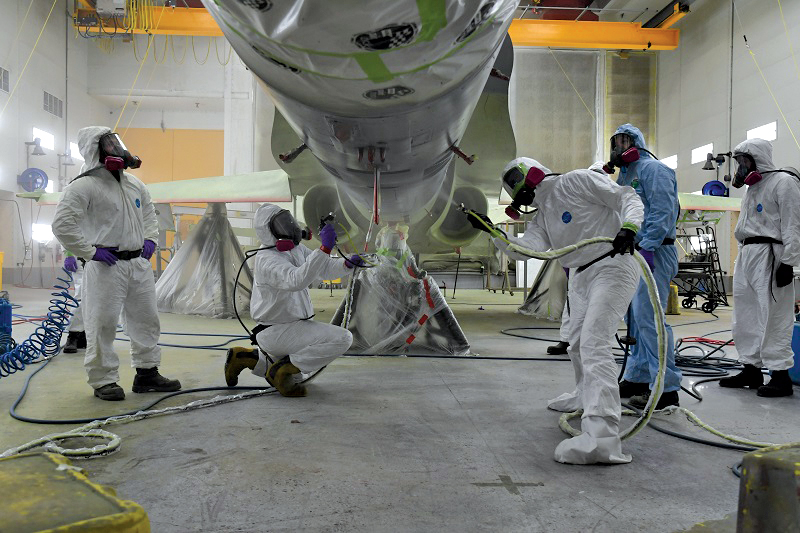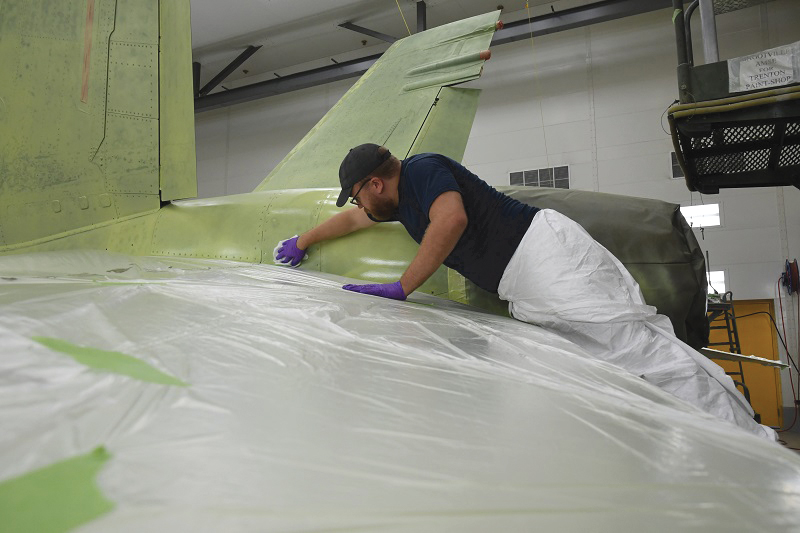No Ordinary Paint Job: The CF-188 Hornet
By Lookout on Aug 25, 2021 with Comments 0

Corporal Frederick Schinck (second from the left) and Aviator James Schneider (centre, third from the right) apply the first coat of NATO standard gray to the underbelly of a fighter jet at Aerospace and Telecommunications Engineering Support Squadron. Photos by Stacey Payne, ATESS
Captain Bettina McCulloch-Drake
1 Canadian Air Division Headquarters Public Affairs
––
When you want to paint your house, you can find the necessary paint in a variety of home hardware and paint specialty stores.
When you want to paint a Canadian Armed Forces fighter aircraft, you need something that can survive speeds of more than 2,200 kilometres per hour or Mach 1.8.
“It is a very specific type of paint that we have to order,” says Captain Jeff Chacko, a Workshop Support Officer with Aerospace and Telecommunications Engineering Support Squadron located in Trenton, Ontario. “The paint has specific properties that enable it to be effective in operations. Greater attention must be given when painting these aircraft. If there are imperfections in the painting, there can be losses in aerodynamic efficiencies that can have more significant consequences such as accelerated fuel burn and accelerated deterioration of the aircraft skin.”
The Squadron has a dedicated team of 10 aircraft structures technicians who sand, prime, and paint each aircraft that comes into the squadron’s paint bays. They are tasked to paint the first six Australian fighter aircraft purchased by the Government of Canada to supplement Canada’s CF-188 Hornet fleet.
Trained and authorized as aviation painters, these technicians follow procedures laid out by the original equipment manufacturer to ensure the highest quality of work.
The first step to any paint job is to prepare the workspace, cover or tape any surface that is not to be painted (such as air intakes or exposed areas where controls exist), and put on personal protective equipment such as respirators and Tyvek suits.
“The second step in painting an aircraft is to sand down the surfaces to remove old paint and markings,” explains MCpl Nick Fedele. “Sanding also reveals any surface imperfections that need to be rectified before painting begins.”
Even with the assistance of power tools, sanding can be taxing physically especially in warm weather.

Corporal Martin Savard, an aircraft structures technician, cleans off the surface of a fighter jet before the first layer of NATO standard grey is applied.
“We ensure our techs get the rest and hydration they need during the procedure,” says Capt Chacko. “We also rotate our techs in and out so that work can remain continuous once started.”
Once sanding is completed, all the surfaces are washed down and the shroud coverings that are in place to fill gaps in the aerodynamic structure and certain panels are removed for ease of painting.
Then the primer, which enables the paint to adhere better to the metal, is applied across the entire surface of the aircraft. After the primer has dried, the first layer of paint is applied.
“We use paint gun systems that include pressure pots and mixers,” says MCpl Steve Leblanc. “The pressure pots help to keep the flow of paint consistent, enabling us to apply a smooth coat over all of the surfaces that are to be painted.”
Once the first coat of paint is applied technicians will let it dry for one day. Then, the second coat, along with any markings and decals, are applied.
When all the painting is finally complete on a single aircraft, a total of eight to 10 gallons (or between 32 and 40 litres) of NATO standard grey paint has been used.
––––
Filed Under: Top Stories
About the Author:





